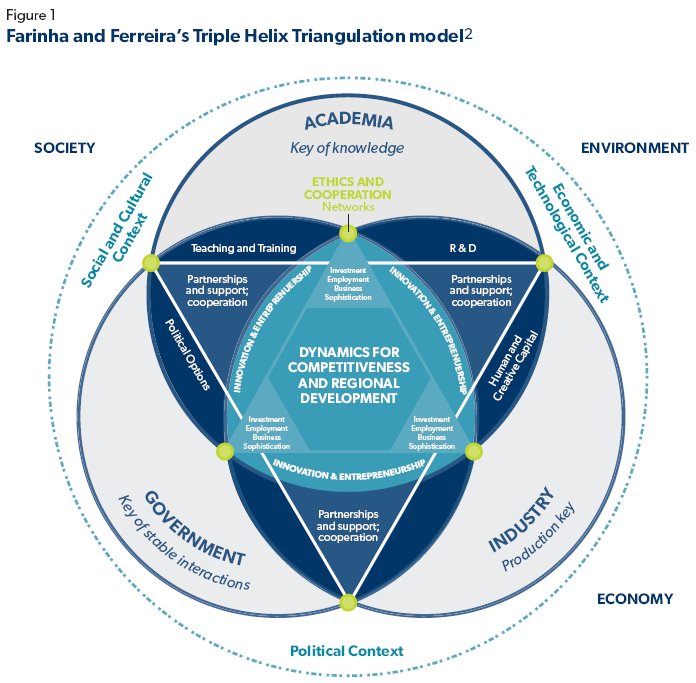
The Organization of Power
Part 1
In the United States, the organization of power is the organization of money. The dysfunctions of our government are directly due to that organization. The nature of the organization is fascist and the design of the economy - their design, serves only their interests - not the interests of our country and not the interests of the people.
The definition of the word: design1
1. A plan or representation of a thing by an outline: sketch: first idea represented by visible lines, as in painting or architecture; a delineation.
2. A scheme or plan in the mind; purpose; intention; aim; in a bad sense, an evil plan or scheme; plot.
The following diagram is a graphic depiction of the design of the 'New Economy' - the so-called Knowledge Economy. It was found on the website of a consulting firm called Collaborative Economics. The Chairman and CEO of Collaborative Economics is Doug Henton.
The diagram is on page 6 in the report titled, The Role of Innovation Brokers in a Knowledge Economy* . The text above is the diagram is exactly as written in the report:
The Triple Helix “is a model for capitalizing knowledge in order to pursue innovation.”1 Knowledge, particularly the kind generated at universities and national labs, and the processes, networks and resources that transform it into useful, commercializeable innovation are at the heart of the Triple Helix model: the powerful combination of Academia, Industry, and Government. The premise of the Triple Helix model is that these three entities can and should work together to make sure ideas and knowledge generated in research institutions (many of them publicly funded) end up in the marketplace and drive innovation.
To capitalize on the knowledge of universities and national labs, Academia needs to take responsibility not just for educating and creating knowledge, but for seeing that knowledge is put to use. Industry in turn must view academia as an important partner and source of knowledge, worthy of capital and human resource investment. Government has an important role to play in funding research and operating a regulatory environment that incentivises innovation and expedites relevant dispersion of important knowledge. The Helix’s three strands paint a poignant image, evocative of DNA and the double helix that is the basis of life, but when Farhina and Ferreira model the Triple Helix as part of resilient regional economy we start to see a more complex picture.

The Triple Helix System is not an American economic system in any sense of the word. It is not free enterprise. It is a system that serves the interests of business - and only business in that it socializes business costs and privatizes profits - for the select few. Study it well. It is the model of Corporatism in the 21st Century.
Since Farinha and Ferreira drew the graphic, I searched on their names and found that there is a Triple Helix Association headquartered in Turin, Italy and that they have annual conferences.
The 1996 Conference held in Amsterdam had an outline of subjects that were probably presented at this first conference of the Triple Helix Association. The following is from that outline - highlights added:
IV. UNIVERSITIES IN KNOWLEDGE BASED ECONOMIES
13. The Entrepreneurial University and the Emergence of Democratic Corporatism
Henry Etzkowitz
It's not as if the move towards corporatism is a secret in the United States. There is ample evidence that it is discussed openly in closed circles - meaning that it just isn't discussed in the mainstream media except for the occasional Op Ed.
 |
"Fascism should rightly be called Corporatism as it is a merge of state
and corporate power" Benito Mussolini |
The best description of corporatism I could find was on the Canadian Encyclopedia website in an article titled Corporatism. The follow are excepts from the article with highlights added:
|
||||||||||
The description above was written from a historical
perspective. Updating to today, the labor component has been replaced with
academia with the universities involvement as shown in the Triple helix diagram.
If you've been paying attention to the redesign of our education system, you'll notice that the central theme is vocational education which is the implementation of functional organization of the economic system. There are references all over the Internet to the "The New Economy" but few explain exactly what is meant by that. So now you know. The new economy is simply an updated version of the old idea of fascism which was the updated version of the old idea of feudalism. And here we go again.
Vicky Davis
December 3, 2013
* The webmaster on the
Collaborative Economics website moved the report so I had to use the local copy
I captured. Here is the original link:
http://www.coecon.com/Reports/Innovation/RoleInnovationBrokers_KnowledgeEconomy_web.pdf
1 Webster's Monarch Dictionary, Splendid Edition, American
Publishing Company, 1909